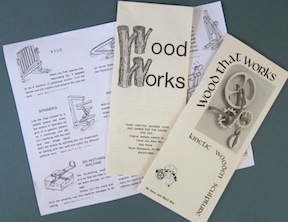This is the fifth in a series of blogs about my history in the craft industry. If you missed the other posts start here.
Given the era of the early Wood That Works years, it was not a marketing priority to check the availability of our domain name but it was important to get business cards and brochures printed. The angst and cost associated with these tasks have thankfully been mitigated with new technologies but for the sake of recording a little of history we are sharing our experiences. I don’t feel old enough to be using the phrase, “Remember when,” but certain phases of business development today bear little resemblance to our options back then. It illustrates how rapidly the desktop publishing revolution (a term not coined until 1985) completely changed this process.

In the ‘70’s creating print material required error free copy (without the use of a spell checker), rub & press letters, offset printing, and large print runs. We literally cut and pasted using scissors and glue to create an original document. In order to keep printing affordable, we had to create a brochure that could be used for a long time. This, along with the impossible goal of showing motion in a still format, were our two main challenges.
The very first publishing endeavor reflected our inexperience. It was hand sketched and basic. We did have the text typeset (choice of four fonts) but as with other brochures, no matter how many times one proofed it, as soon as we got it home from the printers we'd find a typo. Oh, for the joy of a delete key!

We soon ventured into photography and made many attempts at showing motion in a still photo. Not only did we predate computers but consumer video equipment as well. Still photography was the available choice. All efforts produced photos that, although showing motion, always appeared as frenetic speed. Photography didn’t capture the rhythmic and peaceful motion of David’s work. We opted for still photographs instead although kept experimenting.

Our brochures and pamphlets went through ever-changing versions in search of the ideal presentation. David’s work has always been produced in limited editions and a minimum run of brochures lasted long after the sculptures did. Hence, 35 years later I still have stacks of original copies. I designed 3-fold brochures, 5-fold brochures, and multi-page insert brochures (a design disaster). For many years I spent evenings spray gluing colored photographs onto pages because that was the only affordable way to add color.
And then in 1984, along came a Macintosh, WYSIWYG software, soon to be followed by an Apple Laser printer. A revolution for small business was started and we rode the wave of early adoption.
A closing note: A willingness to learn new things coupled with teamwork was essential in establishing Wood That Works. David designed sculptures, I designed brochures. We learned wood working, photography, videography, computing and desktop publishing. We are still learning today. It keeps us young!
